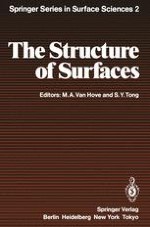1985 | OriginalPaper | Buchkapitel
Theory of the Scanning Tunneling Microscope
verfasst von : J. Tersoff
Erschienen in: The Structure of Surfaces
Verlag: Springer Berlin Heidelberg
Enthalten in: Professional Book Archive
Aktivieren Sie unsere intelligente Suche, um passende Fachinhalte oder Patente zu finden.
Wählen Sie Textabschnitte aus um mit Künstlicher Intelligenz passenden Patente zu finden. powered by
Markieren Sie Textabschnitte, um KI-gestützt weitere passende Inhalte zu finden. powered by
The recent development of the “scanning tunneling microscope” (STM) by Binnig et al. [8.1–5] has made possible the direct real-space imaging of surface topography. In this technique, a metal tip is scanned along the surface while ad justing its height to maintain constant vacuum tunneling current. The result is essentially a contour map of the surface. This contribution reviews the the ory [8.6–8] of STM, with illustrative examples. Because the microscopic structure of the tip is unknown, the tip wave functions are modeled as s-wave functions in the present approach [8.6, 7]. This approximation works best for small effective tip size. The tunneling current is found to be proportional to the surface local density of states (at the Fermi level), evaluated at the position of the tip. The effective resolution is roughly [2Å(R+d)]1/2, where R is the effective tip radius and d is the gap distance. When applied to the 2x1 and 3x1 reconstructions of the Au(l10) surface, the theory gives excellent agreement with experiment [8.4] if a 9 Å tip radius is assumed. For dealing with more complex or aperiodic surfaces, a crude but convenient calculational technique based on atom charge superposition is introduced; it reproduces the Au(l10) results reasonably well. This method is used to test the structure-sensitivity of STM. The Au(l10) image is found to be rather insensitive to the position of atoms beyond the first atomic layer.
